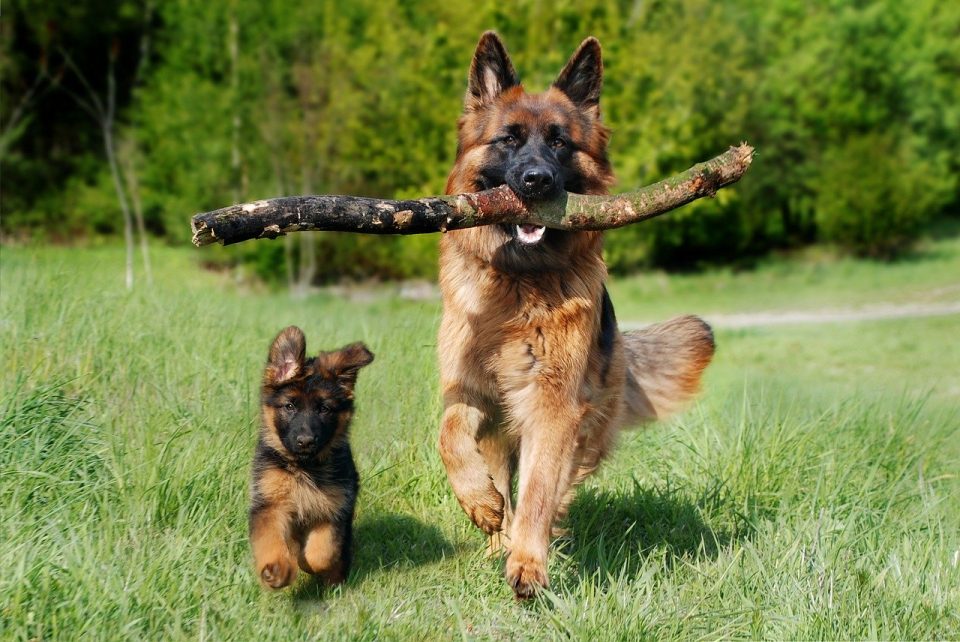A Little About German Shepherds
German Shepherds are classed as medium to large-sized dogs with the standard height at the shoulder being between 60-65 cm in height. Females will be slightly smaller at between 55-60cm.
The breed has a black nose and strong jaws. The forehead is domed, and the muzzle is square shaped.
Ears are large and erect although when the dog is running the ears tend to lie flatter. The tail is bushy.
You may also know the breed as Alsatian, and this is because they used to be known this way in the UK during the First World War until around 1977.
It was then changed to the German Shepherd. The breed is relatively modern dating back to 1899.
Short History of German Shepherds
The German Shepherd was originally a working dog of medium to large size. The breed originated in Germany. The dogs used to work at herding sheep.
Because of the intelligence and train-ability, not to mention the strength and obedience, the breed soon evolved to many other types of work.
They now work at various things including search-and rescue, disability assistance, military and police service and even acting.
The breed is now the second-most registered breed with the AKC and the 7th in the UK Kennel Club.
What is a German Shepherds Coat Like?
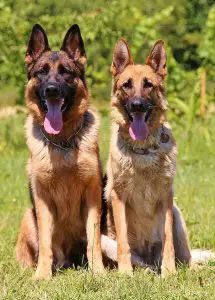 German Shepherds have a double coat. This is made up of a top layer which is dense and closely knit, while the undercoat is very thick.
German Shepherds have a double coat. This is made up of a top layer which is dense and closely knit, while the undercoat is very thick.
The breed has two types of coat, namely medium and long with the long-haired type being less common.
Generally, the German Shepherd coat will be tan/black or red/black.
There are colour varieties which include sable, pure white (very rare), pure black, silver, liver, blue and panda shadings.
All of these are unusual with the blue and liver variants considered as faults at showing.
An all-white dog is also instantly disqualified from showing in the All-Breed section and any Speciality Shows.
The double coat serves to keep the dog warm in the winter months and keep it safe from harmful UV rays in the hotter months.
The outer coat is often referred to as the ‘guard coat’ and is coarse and dense. This coat is straight and flat, lying close to the skin.
If you part the hairs to the undercoat you will find that it is softer and thicker. It is also longest and thickest around the neck area.
German Shepherds have four different types of coat and it is important that you know which type your dog has before you groom it
- Short with an undercoat
- Medium with an undercoat
- Long with an undercoat
- Long with no undercoat
If your German Shepherd has long hair you will see the typical feathery tufts on the ears and tail, as well as on the back of the legs.
Dogs with no undercoat also have the feathering effect on their ears and legs although the outer coat is not as coarse as with a dog who sports an undercoat.
Do German Shepherds Shed?
The breed is recognized as shedding – a lot! Some of the dogs shed more than others, but they all shed profusely with massive amounts of dropped hair seasonally.
German Shepherds shed all-year round and have a huge blow seasonally. This is where they will literally drop vast amounts of hair over a short period of time.
There are some things which will make them shed worse such as poor diet and dehydration. They are also known to shed if stressed. Some medical conditions will cause an increase in shed hair.
How Much do German Shepherds Shed?
The simple answer to this is that German Shepherds shed vast amounts of hair.
Their hair grows all-year round and so old hair falls out as it is replaced by new hair.
Because of the thick undercoat they will shed hair to cool them down as the hot weather approaches.
They will also shed to replace hair which has dropped out naturally.
The dog will however keep approximately the same amount of hair all through the year.
What makes it so dramatic is the amount which is shed – this is because both coats are being replaced.
When preparing for winter the overcoat is shed so that the thick undercoat can grow in.
This is often called the Seasonal Coat Blow. It is a massive amount of shedding and can continue for several weeks.
How to Combat German Shepherds Shedding/ Can I Reduce the Amount They Shed?
There are some things that will keep the shedding under control, although it is important to realize that this is a breed which sheds profusely, and you will never be able to stop it.
You can keep the amount of hair relatively under control.
A good diet will keep the skin and hair healthy and fresh water on an ‘as-and-when’ basis is essential as dehydration will cause more hair to drop.
Grooming daily must be a part of your routing if you are to keep your house from being swamped with hair.
Grooming is really the only way to keep shed hair from accumulating in the house. You should brush the dog daily and give it a thorough grooming session once a week.
A bath ever few weeks may also help. Make sure you use dog shampoo and not your own as this may irritate the skin.
Equipment Help to Combat German Shepherds Shedding
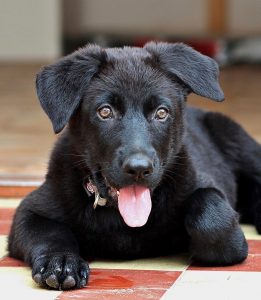
There are several pieces of equipment which should be included in your grooming basket.
De-tangling tool
This is useful for removing any knots and tangles, particularly in the area behind the ears and at the back of the legs. If knots are a constant problem, try using some coat conditioner before you start brushing.
De-shedding tool
You’ll need one of these for getting rid of any loose hairs of the undercoat. You should start working from the dog’s head down towards the tail.
Pin brush
This is important for getting rid of any debris which is caught in the hairs of the undercoat.
Soft-bristle brush
This brush will help to remove the last of the excess hairs and to lift the coat. It will also give the coat a shiny look. Start at the head and work down to the tail with long, smooth strokes.
German Shepherd Grooming Tools
The Furminator de-shedding tool is best to remove the loose undercoat and should be in your grooming basket. These are normally available in several sizes, depending on the length of the coat.
For routine brushing, you may want to add a slicker brush. This is also useful during the heavy shedding season.
This type of brush will get through the thick undercoat and remove any dead hair. Make sure that the ends of the brush have rounded ends so that you do not scratch the skin.
De-matting rakes are useful for teasing out the tangles and mats before you begin to groom the dog.
Are German Shepherds Considered to be Hypoallergenic?
In German Shepherd’s owners circles you may hear this breed referred to the ‘German Shedder.’
This should give you a clue as to whether the breed is hypoallergenic – they are not. While no breed is ever truly hypoallergenic, the German Shepherd is not even remotely hypoallergenic.
If you want a dog who leaves your house hair-free and tidy, then this dog is not the choice for you as they will drop their hair in handfuls!
German Shepherds will shed all through the year, as well as having a seasonal drop twice a year where they lose a huge amount of hair over a short period of time.
Do Some German Shepherds Shed More Than Others?
It is a strange thing to see but often a long-haired German Shepherd will shed less than the short-haired type.
The reason for this peculiarity is that as the undercoat falls away it becomes trapped by the long outer layer and so there is marginally less hair dropped through the house.
This means that it is very important to brush regularly because the trapped hair will tangle and mat, and leave the dog is a great amount of discomfort.
Both types of hair need to be groomed regularly to keep knots out.
How to Groom a German Shepherd
Brushing
Start with a good brush. For short-haired dogs use the bristle brush and for long-haired dogs go for the pin brush.
Start at the head and work down to the tail. Never go against the hair growth as this will hurt the dog.
For any stubborn knots, tangles or mats you should use a de-tangle brush. For bad knots, you may need to cut them out with a pair of scissors.
Bathing
If you are going to bath your German Shepherd you only need to do this about every four months, depending on the condition of the hair.
This breed has a lot of natural oils in the coat and bathing too often will strip them. This will lead to dry skin which is easily irritated.
You should never use a human shampoo on your dog as it will irritate his skin. This is because the pH on the dog is different from human pH.
German Shepherds respond well to a mild and hypoallergenic shampoo for the body, and a tea-tree shampoo for the head area.
Often it is easier to bath the German Shepherd in the back garden and make use of the hose set on a low pressure.
This is because they are such large dogs and while they will fit into a bath, they will soak the entire area when they shake the water off. Being outside will save your bathroom!
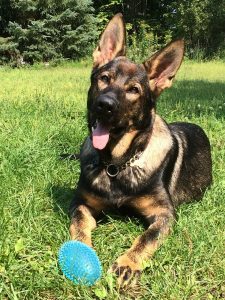
If you choose to bath the dog in the bathroom you should use a non-slip mat in the bath so that he does not slip and injure himself.
Double coated German Shepherds should not have conditioner used on their hair, but other types can have tear-free shampoo and conditioner applied to their hair.
Many breeds which have double coats will feel a hairdryer too hot, so you should rather dry the German Shepherd with a towel or if using a dryer stay on the lowest setting.
After the hair is dry you should brush it again to remove any remaining knots or tangles.
Health Reasons for Increased Shedding in German Shepherds
There are several health reasons why the German Shepherd will shed more than is ‘normal’.
Allergies
These can be food based or environmentally caused. Allergies can lead to inflammation and an itchy skin which will lead to hair falling out.
Dehydration
Shedding in German Shepherds is often made worse by dehydration. This leads to dry skin which causes more shedding.
It is important that the German Shepherd always has fresh water. If the dog is not an avid water drinker, you should offer wet food as these contain up to 75% moisture.
Stress
German Shepherd can experience stress from things such as separation anxiety.
They can also become bored which can lead to them feeling stressed. A stressed dog will shed more than usual.
Parasites
Because of the thickness of the hair there is always the possibility of picking up fleas and other parasites when out walking.
Fleas can cause dandruff as well as irritate the skin which leads to excessive shedding.
Health problems
Generally, the German Shepherd is a healthy breed although any undiagnosed medical issues will cause them to shed more.
If you feel that the dog sheds more than is normal, then you may want to have him checked out by your vet.
Some Things to Reduce Shedding
Add oil
Olive oil or flaxseed oil added to the diet will improve the condition of the coat. Omega-3 supplements are a good idea to keep the skin healthy.
Check the diet
Unhealthy and ‘cheap’ food will cause heavy shedding. This is because cheap foods are often made from corn and grain which the dog may not be able to easily digest.
Make sure that the first ingredient of the food is meat. If you need to change the diet, it should be done gradually over a period so that you can monitor the heath of the dog.
Check for fleas
Fleas and parasites will cause inflamed areas and hair drop.
If you walk the dog out in the country, you should make sure to check for parasites after every walk.
Water
Always make sure that the German Shepherd has a fresh supply of water.
Not drinking enough water will lead to dry skin which will increase shedding and make them ill.
Fruit and veggies
Many fruits and vegetables are good for dogs.
Lean meat is also good to add to the diet as this will keep the skin in good condition and prevent extra shedding.
Groom often
Brush regularly to remove excess fur and to keep the knots and tangles away.
In good weather you may prefer to brush the dog outside to prevent hair from flying around the room.
How Do I Know What Too Much Shedding Is?
Although the German Shepherd sheds a huge amount, there are some things to watch out for which may indicate that there is a problem.
The German Shepherd, while shedding huge amounts seasonally, does not do this all the time. Excessive shedding all the time is an indication of another issue.
If you see anything on the coat which is out of the ordinary, you should check with the vet. Any adverse skin condition needs to be investigated.
- Excessive scratching or shaking
- Inflamed, red areas
- Bald areas
- Flaky, dry areas
- Wounds
- Any discharge
Final Thoughts
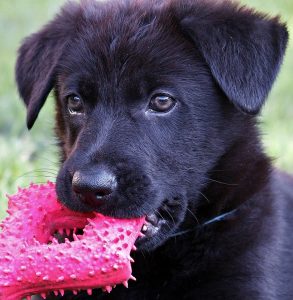 There is no doubt that German Shepherds shed a lot, and they shed all year long.
There is no doubt that German Shepherds shed a lot, and they shed all year long.
Although you will never be able to stop the amount of hair, there are things which you can do to reduce it and keep it under control.
Having a balanced, healthy diet and fresh water always will go a long way to stop extra shedding, as will keeping the skin parasite free.
If the German Shepherd is kept in good health, with both a good diet and regular grooming they will make a loyal and loving pet and a good companion for many years.
